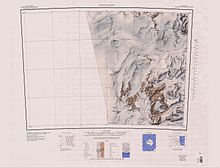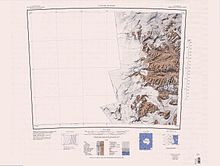Antarctic dry valleys

As McMurdo Dry Valleys ( English Antarctic Dry Valleys or McMurdo Dry Valleys ) refers to a series of ice-free valleys (an Antarctic oasis ) in Victoria Land in East Antarctica . The largest are Victoria Valley , Wright Valley, and Taylor Valley . Due to the extreme conditions prevailing there, a world-wide unique landscape with unique living beings has developed.
location
The valleys represent part of the Transantarctic Mountains that cross the Antarctic over a length of around 4000 km. They are on the western coast of McMurdo Sound across from Ross Island . Together they have an area of 51,300 km², of which 11,300 km² are ice-free. The Antarctic dry valleys begin at around 77 ° 15 'south and end at around 77 ° 45' south, and they are between 161 ° East and 163 ° East. The Taylor Valley extends farthest to the east (approximately to 163 ° 30 ′ east), while the Victoria and Wright valleys extend further west (to 160 ° 30 ′ east).
Dry valleys - overview
- Alatna Valley is the northernmost, north of the Benson Glacier .
The three main valleys from north to south are:
- Victoria Valley (between St. Johns Range in the north and Olympus Range in the south)
- Wright Valley (between Olympus Range in the north and Asgard Range in the south)
- Taylor Valley (between Asgard Range in the north and Kukri Hills in the south)
West of the Victoria Valley are, from north to south:
Lies west of the Taylor Valley
- Pearse Valley (sometimes incorrectly referred to as Pearce Valley )
Located southwest of the Pearse Valley
Further south, between the Royal Society Range in the west and the west coast of McMurdo Sound on the glacier tongue of the Koettlitz Glacier , from north to south:
The Victoria Valley is the northernmost and has a length of around 40 km. It is also the smallest of all three valleys. To the south of this is the Olympus Range , which is also largely ice-free and has a maximum altitude of 2180 m .
The Wright Valley, which is south of the Olympus Range , has a length of 60 km; What is noticeable here is that, with an average of 8 km, it is wider than the other valleys (2 km on average) and has less height differences. To the south the valley rises to the Asgard Range , which however is covered with snow in places . This mountain range has a maximum height of 2410 m . The Onyx, the longest river in Antarctica, flows through the Wright Valley .
The Taylor Valley is around 50 km long. Unlike the Wright Valley and the Victoria Valley, which flow into the Wilson Piedmont Glacier towards the sea, the Taylor Valley ends directly in McMurdo Sound. This makes it easier to reach than the other valleys and therefore most popular for research.
Climatic conditions
The climatic conditions in the McMurdo dry valleys are among the most extreme on earth . The landscape is a hyperarid polar desert , with minimal rainfall of 3 mm to 50 mm water equivalent per year. During the Antarctic winter , temperatures drop to below −50 ° C, even in summer they reach a maximum of −10 ° C, temperatures around the freezing point of 0 ° C are extremely rare.
At the former New Zealand Vanda station on the lake of the same name in the Wright Valley, however, the highest temperature ever recorded in Antarctica was reached on January 5, 1974, at 15.0 ° C.
Hurricane-like winds blow from the land all year round , splitting and destroying rocks and boulders. Only very rarely do they bring some snow from the glaciers with them.
The Antarctic dry valleys are drier and more hostile to life than the Atacama Desert in Chile or the Sahara .
One consequence of these conditions is that the soils are extremely saline . In some areas there are puddles of water that do not freeze due to the high salt content .
Reasons for the extreme conditions
The main reason for these extreme conditions is the location of the Transantarctic Mountains. This mountain range shields the valleys from the continental ice of East Antarctica. The glaciers are held back by the mountains and cannot penetrate to the sea, for example to McMurdo Sound.
On the one hand, the continental ice often does not reach the same height as the peaks of the transantarctic mountain range. The winds that now flow over the continental ice to the mountains lose their snow on the peaks of the mountain range. As soon as these are exceeded, the dry winds drop steeply and blow through the valleys to the sea. As a result of their dryness, the winds "suck" the last of the moisture out of the valleys.
However, the above conditions only apply to the Antarctic dry valleys; they are only applicable to a limited extent in other regions. In other parts of the transantarctic mountains are much more broken, so that the Antarctic continental ice can flow over the mountain ranges to the sea. In such areas, often only the peaks protrude from the Arctic Ocean. The continental ice in other regions of the Transantarctic Mountains also presses against the mountain range with much higher pressure.
ecology
The ecological conditions in the region are unique in the world. However, life does not take place on the surface of the valleys themselves, as the conditions are too extreme for a nutrient cycle to develop. In the dry valleys, however, there are some lakes that are up to 80 m deep and have largely frozen over for millions of years. However, these lakes thaw on the shores with millimeter-sized gaps in November, so that life there has a chance of existence. But the Onyx River and puddles of water, which also do not freeze over due to their salt content, harbor microscopic life.
Waters
Lakes
Some of the lakes are among the most salty bodies of water on earth, with higher salinity than the Assal Lake or the Dead Sea . This list is headed by small Don Juan Lake in the upper Wright Valley 9 km west of Lake Vanda .
- Vidasee (Victoria Valley)
- Lake Vanda (Wright Valley)
- Lake Brownworth (Wright Valley) (freshwater)
- Don Juan Lake (Wright Valley)
- Fryxellsee (Taylor Valley)
- Hoaresee (Taylor Valley)
- Lake Chad (Taylor Valley)
- Parera Pond (Taylor Valley) (freshwater)
- Bonney Lake (Taylor Valley)
Flowing waters
- Kite Stream (Victoria Valley)
- Onyx River (Wright Valley)
- Vincent Creek (Taylor Valley)
- Crescent Stream (Taylor Valley)
- Harnish Creek (Taylor Valley)
- Huey Creek (Taylor Valley)
research
The Antarctic dry valleys are extremely interesting for research. The living beings there only occur in these valleys. In addition to studying ecology , fossils also play a major role. These are practically frozen in the climate and have been excellently preserved. The NASA is interested in the valleys, as they are similar to the structure of the surface of Mars. In November 2012, after taking samples from Lake Vida, researchers reported detection of at least 32 different extremophilic bacterial variants that could be assigned to eight different strains.
literature
- Antarctica - Pushing the Limits of Life. In: Geo . 11/2006
- Wolf Dieter Blümel: Physical geography of the polar regions . Teubner study books, Leipzig 1999, ISBN 3-519-03438-7 .
Web links
- Map of the Dry Valleys. ( Memento of March 27, 2009 in the Internet Archive ) (PDF; 459 kB)
- Antarctica: Ancient Archives. ( Memento from February 6, 2013 in the web archive archive.today ) Report on the dry valleys. In: Geo . 11, 2006.
- The McMurdo Dry Valleys (English)
- Panoramic photos of the Taylor Valley
Individual evidence
- ^ Joseph Levy: How big are the McMurdo Dry Valleys? Estimating ice-free area using Landsat image data. In: Antarctic Science. 25.01, 2013, pp. 119-120. ( online (PDF; 126 kB))
- ↑ DR Marchant et al .: A review of geomorphic processes and landforms in the Dry Valleys of southern Victoria Land: implications for evaluating climate change and ice-sheet stability. In: Geological Society, London, Special Publications. 381.1, 2013, pp. 319-352. ( online (pdf; 12 MB))
- ↑ James W. Head, David R. Marchant : The climate history of early Mars: insights from the Antarctic McMurdo Dry Valleys hydrologic system. In: Antarctic Science. June 26, 2014, pp. 774-800. ( online (pdf; 3.62 MB))
- ^ Clarke, Jonathan DA .: Antiquity of aridity in the Chilean Atacama Desert . In: Geomorphology 73.1 . 2006, p. 101-114 ( researchgate.net ).
- ↑ Klaus Taschwer: An isolated lake in the Antarctic for 2800 years has harbored life . at: derstandard.at , accessed on November 27, 2012.
- ↑ Bacteria isolated under the Antarctic ice for 2,800 years. In: Spiegel online. Retrieved November 27, 2012.







